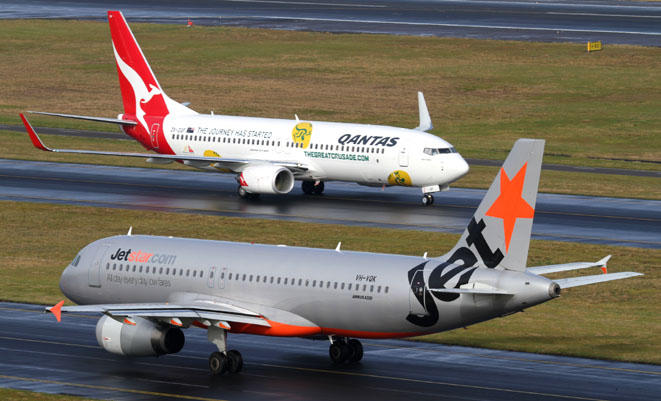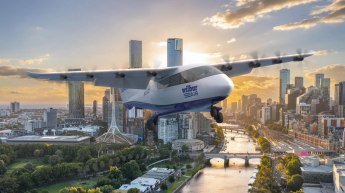
Qantas says its group domestic operations – Qantas Domestic (including QantasLink) and Jetstar – have posted an underlying EBIT of “just below” $50 million for the 2014 financial year, which CEO Alan Joyce says makes them “in all likelihood, the only profitable airlines in the domestic market”.
While the Qantas accounts do not break out Jetstar’s domestic and international figures, it reported a Qantas Domestic EBIT profit of $30 million, suggesting Jetstar’s domestic EBIT was just below $20 million.
Revenue from Qantas’s domestic operations declined due to capacity still being “well ahead” of demand, for “a second consecutive year”, Joyce said in his speech announcing the airline group’s annual results on Thursday, but noted that both the Qantas and Jetstar domestic businesses improved unit costs, offsetting falling revenue and rising fuel costs.
Further, domestic capacity growth is tailing off.
“Overall domestic capacity growth in the first half of 2015 is likely to be around one per cent,” Joyce said, who, offered a more nuanced line about Qantas Group domestic marketshare.
“Our domestic position has always been very clear, and I suppose we’ve simplified it sometimes by saying (it is a) ‘65 per cent line in the sand’, but it has been more complex than that, making sure we have a network and frequency advantage for Qantas across the board and a product advantage,” Joyce told reporters.
“Part of the reason why we have been so successful in retaining our position in the corporate market is because of our network, our frequencies, the destinations we serve as well as our loyalty program, our product, our on-time performance. They all go hand in hand. And we will protect that position going forward, but we do believe that given the market circumstances that we’re seeing today, with weakness in the resources sector and government travel in particular, that it is sensible for us not to grow capacity for this half.”
In line with that flat capacity growth, Qantas announced it will not extend leases on two domestic Airbus A330-200s in the next (2106) financial year, as well as selling off two 737-800s (one allocated to Qantas Domestic, one to the New Zealand operation) and two QantasLink Dash 8 Q300 turboprops this financial year.
Alan Joyce also outlined in his speech that he expects Qantas Domestic’s unit cost disadvantage compared to Virgin Australia will fall to within five per cent.
“We believe we have come down from 18 per cent to 15 per cent (today), but we will see that confirmed tomorrow (when Virgin Australia announces its results),” CFO Gareth Evans explained. That means a further reduction in the domestic business’s cost base of 10 percentage points.
“So there is a significant amount of benefit that will flow through to the domestic business as part of the transformation,” Evans continued.
“A big one that will occur during this current financial year is the retirement of the 767 aircraft and the fleet utilisation and simplification benefits that come from that, so that will be a big step in closing that cost gap.”
Jetstar, meanwhile is experiencing flatter domestic demand.
“We want Jetstar to be the lowest cost operator with the best network for a leisure carrier operating in the market,” Joyce explained.
“Jetstar has far better economics than its competitor, lower costs, better revenue. That’s because it offers a better network. We are going to protect that and making sure we maintain that competitive position, but again there has been some weakness in consumer confidence. We’re making sure we are targeted in where we place growth for Jetstar.”
Joyce also spoke positively of Jetstar’s position in New Zealand, where, he said, the market had been a lot more “disciplined” that what has been experienced in Australia.
“We’ve seen a significant improvement in loads and in yield, and the market’s been a lot more disciplined in New Zealand than it has been in Australia. There hasn’t been the oversupply of capacity that we saw here, and as a result, I think all carriers are doing well in that market because it is sensible adding capacity with growth and not ahead of growth.”
















Dee
says:Love the Quote” No Oversupply of Capacity in N.Z.”
Who started that war over Aussie Skies ???
Shaun
says:Jetstar’s EBIT was just below $20 million? We all know that Qantas pays most of Jetstar’s expenses, so I’m guessing they really made a substantial part of the loss?
Surely management can see that their low cost model is failing and the only way forward is to reinvigorate the Qantas brand (when was the last time you saw a decent Qantas TV commercial), innovate the product and outsource their workforce to Network, Cobham and other third parties who aren’t so rediculous with their low hours/high ‘god’ mentality.
Message to Alan….Most Qantas passengers don’t want to fly on a budget carrier, no matter how much you cut their schedule options and kill off the mainline brand. Have you actually flown in economy on a Jetstar aircraft??
Ty
says:Shaun, can you please elaborate on how Qantas covers Jetstars ‘expenses’? I think you’ll find Jetstar is one of the few parts of the group holding its own at the moment…